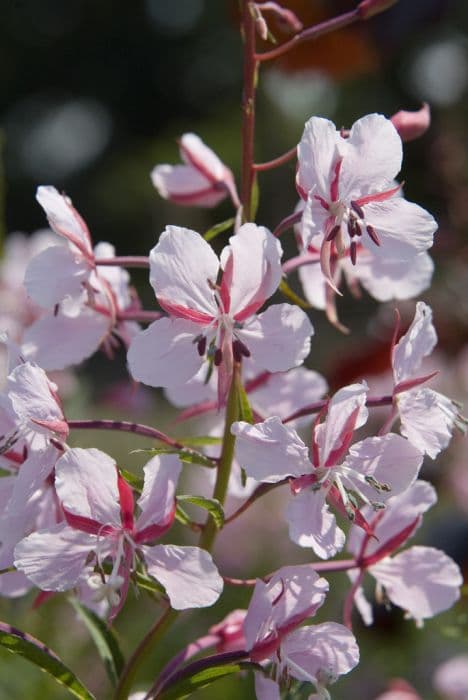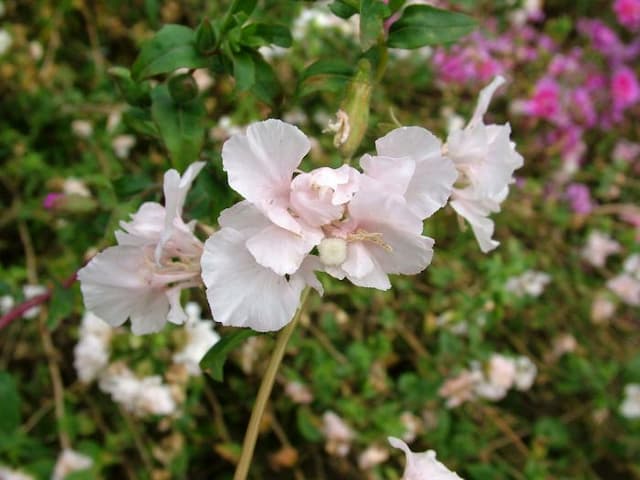Evening Primrose Oenothera versicolor 'Sunset Boulevard'

ABOUT
The Oenothera versicolor 'Sunset Boulevard', commonly known as the Sunset Boulevard evening primrose, is a visually striking perennial that brings a warm display to any garden setting. Its most distinguishing feature is the stunning range of colors its flowers exhibit. The blooms progress through a variety of shades, typically starting as a rich orange-red, transitioning to orange, and finally maturing to a soft yellow. These flowers are cup-shaped and slightly ruffled, providing an impression of delicate exuberance. The plant itself forms a mound of lance-shaped, mid-green leaves that serve as a lush backdrop to the vibrant floral display. The foliage may also exhibit reddish tints, complementing the fiery tones of the flowers. In addition, the Sunset Boulevard evening primrose's flowers have a gentle, pleasing fragrance that adds another layer of enjoyment to its presence in the garden.
About this plant
 Names
NamesFamily
Onagraceae
Synonyms
Evening Primrose, Sundrops
Common names
Oenothera versicolor 'Sunset Boulevard'.
 Toxicity
ToxicityTo humans
Sunset Boulevard Evening Primrose is not widely reported to be toxic to humans. However, as with any plant not known for its edibility, ingestion should be avoided as it may cause mild stomach upset or allergic reactions in some individuals.
To pets
Sunset Boulevard Evening Primrose is similarly not widely reported to be toxic to pets like dogs and cats. However, ingestion of plants not intended for pet consumption can sometimes cause gastrointestinal upset such as vomiting or diarrhea. If a pet consumes this plant and displays signs of illness, consulting a veterinarian is recommended.
 Characteristics
CharacteristicsLife cycle
Perennials
Foliage type
Deciduous
Color of leaves
Green
Flower color
Yellow
Height
24 inches (61 cm)
Spread
18 inches (45 cm)
Plant type
Herb
Hardiness zones
5
Native area
North America
Benefits
 General Benefits
General Benefits- Attracts Pollinators: Oenothera versicolor 'Sunset Boulevard', commonly known as Evening Primrose, is known for attracting bees, butterflies, and other beneficial insects that are vital for pollination.
- Drought Tolerant: Once established, it has good drought tolerance, making it suitable for xeriscaping or gardens in arid climates.
- Low Maintenance: Typically requires minimal care beyond the initial planting and establishment period, making it an easy addition to many gardens.
- Visual Appeal: Adds striking colors to the garden with its vibrant yellow to orange-red flowers that bloom in the evening.
- Wildlife Friendly: Provides a habitat and food source for wildlife, particularly nocturnal pollinators such as moths.
- Erosion Control: Its root system can help stabilize soil and prevent erosion on slopes and banks.
- Long Blooming: Offers a long flowering period from midsummer to fall, providing sustained interest and beauty in the garden.
- Edible Parts: Some parts of the plant are edible and can be used in salads and other culinary preparations (note: always ensure the identification is correct and consult a professional before consuming any plant parts).
- Night Garden Plant: As a night-blooming species, it's ideal for evening and night gardens where its flowers can be appreciated in the dusk and after sunset.
 Medical Properties
Medical PropertiesThis plant is not used for medical purposes.
 Air-purifying Qualities
Air-purifying QualitiesThis plant is not specifically known for air purifying qualities.
 Other Uses
Other Uses- Oenothera versicolor 'Sunset Boulevard', also known as Evening Primrose, can be used as a natural dye source. The flowers and roots can yield subtle yellow to reddish hues for coloring fabrics or yarns.
- Evening Primrose oil, while popular for its health benefits, can also be used in natural beauty products such as homemade face creams and serums due to its moisturizing properties.
- The stems of Evening Primrose can be woven into baskets or other crafts, as they are flexible when soaked and retain strength when dried.
- Pressed Evening Primrose flowers can be used in decorative arts, especially for creating botanical prints or inclusion in resin jewelry due to their distinct color and shape.
- Evening Primrose petals can be added to salads or used as an edible garnish, providing a subtle flavor and a splash of color to culinary dishes.
- The nectar of the Evening Primrose flower can be used to make a sweet and floral-tasting syrup that pairs well with desserts or cocktails.
- Evening Primrose plants can serve as a natural pest deterrent in gardens; their strong scent can help keep certain insects and herbivores away from more sensitive plants.
- With their tall and erect growth habit, Evening Primroses can be planted as a privacy screen or living fence in a landscape design.
- The seedpods of Evening Primrose can be dried and used in floral arrangements or as part of homemade potpourris.
- Photographers and artists may use Evening Primrose as a subject for their work, captivated by the beauty of its flowers that bloom in the evening and its vibrant color transitions.
Interesting Facts
 Feng Shui
Feng ShuiEvening Primrose is not used in Feng Shui practice.
 Zodiac Sign Compitability
Zodiac Sign CompitabilityEvening Primrose is not used in astrology practice.
 Plant Symbolism
Plant Symbolism- Adaptability: The Evening Primrose can thrive in various environments, symbolizing the ability to adjust and flourish in different life situations.
- Resilience: Known for its hardiness, the Evening Primrose exemplifies resilience and the capacity to cope with adversity.
- Persistence: With its habit of opening flowers at dusk and lasting through the night, it represents persistence and endurance through challenging times.
- Beauty and Mystery: Blooming at night, the Evening Primrose suggests there is beauty in the unknown and encourages a sense of wonder and mystery.
- Healing: As the plant has medicinal properties, it symbolizes healing and the nurturing of physical and emotional well-being.
 Water
WaterEvening Primrose requires moderate watering; during active growth, it typically needs water every week. One inch of water per week is sufficient, but be ready to adjust according to weather conditions, watering more in hot, dry periods and less in cooler, damp conditions. Always check the top inch of soil for dryness before watering again. Overhead watering is not ideal as it can promote leaf diseases; instead, water at the base of the plant to keep foliage dry. Ensure the soil is well-draining to prevent waterlogging, which can lead to root rot.
 Light
LightEvening Primrose thrives in full sun. The best spot for this plant is where it can receive at least six hours of direct sunlight daily, which encourages healthy growth and optimal blooming. While it does tolerate light shade, the flowers will be fewer, and the plant may become leggy as it stretches towards the light.
 Temperature
TemperatureEvening Primrose is hardy and can tolerate a wide range of temperatures. It survives in conditions as low as 20 degrees Fahrenheit and as high as 90 degrees Fahrenheit, but the ideal temperature range for robust growth is between 60 and 70 degrees Fahrenheit.
 Pruning
PruningPruning Evening Primrose is done primarily to maintain shape and encourage flowering. Deadheading spent blooms can promote a longer blooming period. Pruning back the plant by one-third after the first bloom cycle can also stimulate a second bloom. The best time for pruning is immediately after the first flowering round is finished.
 Cleaning
CleaningAs needed
 Soil
SoilEvening Primrose thrives in well-draining soil with added organic matter, such as compost or peat moss, to enrich it. It prefers a soil pH ranging from neutral to slightly acidic (pH 5.5 to 7). A mix of two parts garden soil, one part sand, and one part compost or well-rotted manure creates an ideal growing medium.
 Repotting
RepottingEvening Primrose should be repotted every two to three years to refresh the soil and facilitate healthy growth. Overcrowded plants can be divided and repotted in the spring.
 Humidity & Misting
Humidity & MistingEvening Primrose is tolerant of a wide range of humidity conditions and does well in average outdoor humidity levels. It does not require any special humidity adjustments when grown in its natural environment.
 Suitable locations
Suitable locationsIndoor
Place Evening Primrose near a sunny window.
Outdoor
Plant in full sun, well-drained soil, water moderately.
Hardiness zone
4-8 USDA
 Life cycle
Life cycleThe Evening Primrose 'Sunset Boulevard' begins its life cycle when seeds are sown in well-draining soil and have adequate sunlight and warmth to germinate. Upon germination, seedlings emerge and mature into rosettes with foliage characteristic of the species, typically within the first growing season. As the plant enters its second growing season, it develops a sturdy stem and begins to produce colorful, fragrant flowers that open in the evening and remain open until the following day, attracting pollinators such as bees and moths. After pollination, the flowers develop into elongated seed capsules containing numerous small seeds. Once mature, these seeds are released into the environment when the capsules dehisce, either to be collected and sown again or to self-sow and grow where they fall. This perennial plant may die back in colder climates over winter but will regrow from the rootstock the following spring to continue its cycle.
 Propogation
PropogationPropogation time
Spring-Early Summer
The Evening Primrose 'Sunset Boulevard' is often propagated by seeds, which is the most popular method. The best time to sow the seeds is in spring, directly in the ground where they are to grow, as they do not like to be transplanted due to their taproot system. To propagate by seeds, sprinkle the seeds on the surface of the soil and lightly press them down, but do not cover them as they need light to germinate. Water the area gently to moisten the seeds without causing them to wash away. Keep the soil moist but not waterlogged. Germination usually occurs within 2 to 3 weeks, and the seedlings can be thinned out to about 6 inches (approximately 15 centimeters) apart to allow enough room for growth.









